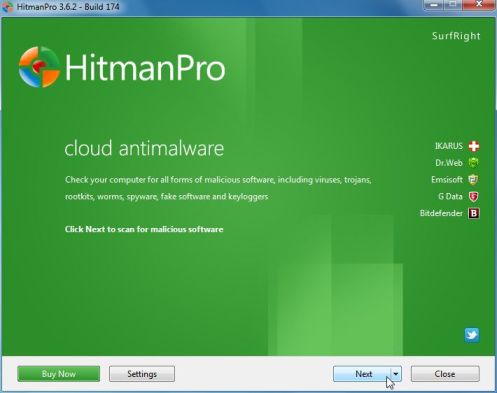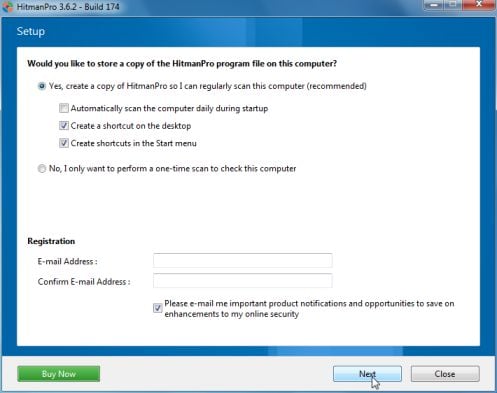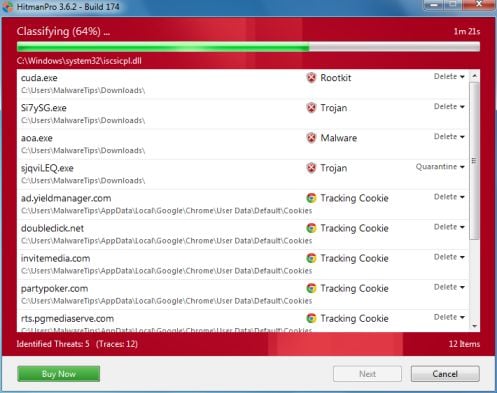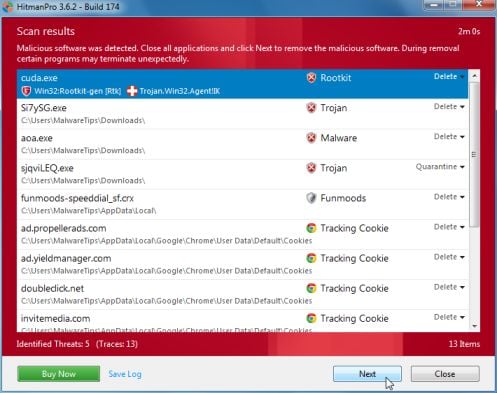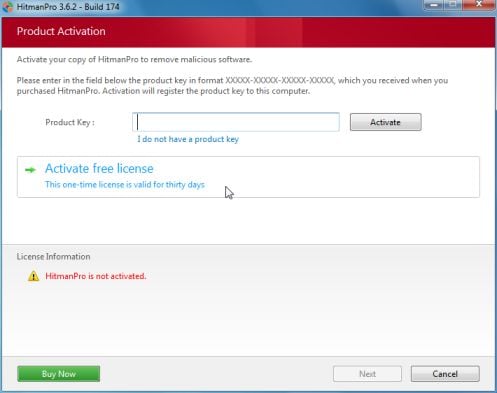The Dirección General de la Policía Ukash Ransom is a computer virus (Trojan:W32/Reveton), which will display a bogus notification, that pretends to be from the Cuerpo Nacional de Policía and states that your computer has been blocked due to it being involved with the distribution of pornographic material, SPAM and copyrighted content.
The Dirección General de la Policía virus will lock you out of your computer and applications, so whenever you’ll try to log on into your Windows operating system or Safe Mode with Networking, it will display instead a lock screen asking you to pay a non-existing fine of 100 Euro in the form of a Ukas or PaySafeCard code.
Furthermore, to make its alert seem more authentic, this virus also has the ability to access your installed webcam, so that the bogus Dirección General de la Policía notification shows what is happening in the room.
If your computer is infected with the Dirección General de la Policía virus, you will see the following lock screen:
![Dirección General de la Policía virus [Image: Dirección General de la Policía virus]](http://malwaretips.com/blogs/wp-content/uploads/2013/02/Direccion-General-de-la-Policia.jpg)
The message displayed by the threat can be localized depending on the user’s location, with text written in the appropriate language. Depending on the variant, the Trojan may only display a message in the language spoken by its authors, or the country that was intended as the main target of the attack.
The Dirección General de la Policía virus may display the following notification:
Dirección General de la Policía
Cuerpo Nacional de Policía
¡ATENCIÓN! Su OP (ordeandor) está bloqueado debido a al menos una de las razones especificadas siguientes.
Usted ha estado violando “Derecho de Autor y Derechos Conexos Ley o (vídeo, música, software) y utilización ilegal o distribución de contenido con derechos de autor, infringiendo así el artículo 128 del Código Penal de Reino de España.
El artículo 128 del Código Penal prevé una multa de 200 a 500 salarios mínimos o la privación de libertad de 2 a 8 años.
Se le ha prohibido ver o distribuir contenido pornográfico (Child Porno zoofilia, y etc). Violando así el artículo 202 del Código Penal de Reino de España.
El artículo 202 del Código Penal prevé la privación de libertad de cuatro a 12 años. Acceso ilegal a los datos informáticos se ha iniciado desde el PC, o si han sido …
El artículo 208 del Código Penal prevé una multa de hasta €100,000 y / o privación de libertad de 4 a 9 años.
Acceso ilegal se ha iniciado desde su PC sin su conocimiento o consentimiento, su PC puede ser infectado por malware. por lo tanto usted está violando la ley sobre el uso negligente de un ordenador personal.
El artículo 210 del Código Penal prevé una multa de €2.000 a €8.000.
Distribución de spam o de publicidad ilícita otro se ha efectuado desde el PC como una actividad con fines de lucro o sin su conocimiento, su PC puede ser infectado por malware. El artículo 212 del Código Penal prevé una multa de hasta €250.000 y una privación de libertad de hasta 6 años. En caso de que esta actividad se ha realizado sin su conocimiento, usted se cae en el citado artículo 210 del Código Penal de Reino de España.
Su personalidad y la dirección están siendo identificados, un caso criminal va a ser iniciado en su contra en virtud de uno o varios artículos mencionados dentro de las próximas 72 horas.
De conformidad con la enmienda al Código Penal del Reino de España de Febrero 04, 2013, esta infracción la ley (si no se repite – la primera vez) puede ser considerado como condicional en caso de que pagar la multa al Estado.
Las multas sólo pueden ser pagados dentro de 72 horas después de la infracción. Tan pronto como 72 horas transcurren, la posibilidad de pagar la multa expira, y un proceso penal iniciado en su contra, automáticamente dentro de las próximas 72 horas! El importe de la multa es de €100. Usted puede pagar una multa Ukash o Paysafecard.
Cuando usted paga la multa, su PC se abrió en 1 a 72 horas después de que el dinero se pone en la cuenta del Estado.
Debido a que su PC está desbloqueado, se le dará 7 días para corregir todas las violaciónes. En el caso de todas las violaciónes no se corrigen después de 7 días hábiles, su PC se bloquea de nuevo, y una causa penal se inició en su contra automáticamente en uno o más artículos mencionados.
The Dirección General de la Policía notification is a scam, and you should ignore any alert that this malicious software might generate.
Under no circumstance should you send any money via Ukash to these cyber criminals, as this could lead to identity theft,and if you have, you can request a refund from Ukash stating that the payment was due to a scam and a computer virus.
Dirección General de la Policía – Virus Removal Instructions
STEP 1: Remove Dirección General de la Policía lock screen from your computer
Dirección General de la Policía Ukash Ransom has modified your Windows registry and added its malicious files to run at start-up, so whenever you’re trying to boot your computer it will launch instead its bogus notification.To remove these malicious changes, we can use any of the below methods :
Method 1: Start your computer in Safe Mode with Networking and scan for malware
Some variants of Dirección General de la Policía virus will allow the users to start the infected computer in Safe Mode with Networking without displaying the bogus lock screen. In this first method, we will try to start the computer in Safe Mode with Networking and then scan for malware to remove the malicious files.
- Remove all floppy disks, CDs, and DVDs from your computer, and then restart your computer.
- Press and hold the F8 key as your computer restarts.Please keep in mind that you need to press the F8 key before the Windows start-up logo appears.
Note: With some computers, if you press and hold a key as the computer is booting you will get a stuck key message. If this occurs, instead of pressing and holding the “F8 key”, tap the “F8 key” continuously until you get the Advanced Boot Options screen. - On the Advanced Boot Options screen, use the arrow keys to highlight Safe Mode with Networking , and then press ENTER.
![Remove Dirección General de la Policía virus (Removal Guide) 1 [Image: Safe Mode with Networking]](data:image/gif;base64,R0lGODlhAQABAAAAACH5BAEKAAEALAAAAAABAAEAAAICTAEAOw==)
- If your computer has started in Safe Mode with Networking, you’ll need to perform a system scan (as seen on STEP 2) with Malwarebytes Anti-Malware and HitmanPro to remove the malicious files from your machine.
IF the Dirección General de la Policía virus didn’t allow you to start the computer in Safe Mode with Networking,you’ll need to follow Method 2 to get rid of its lock screen.
Method 2: Restore Windows to a previous state using System Restore
System Restore can return your computer system files and programs to a time when everything was working fine, so we will try to use this Windows feature to get rid of Dirección General de la Policía lock screen.
- Restart your computer, and then press and hold F8 during the initial startup to start your computer in safe mode with a Command prompt.
Note: With some computers, if you press and hold a key as the computer is booting you will get a stuck key message. If this occurs, instead of pressing and holding the “F8 key”, tap the “F8 key” continuously until you get the Advanced Boot Options screen. - Use the arrow keys to select the Safe mode with a Command prompt option.

- At the command prompt, type cd restore, and then press ENTER.
Next,we will type rstrui.exe , and then press ENTER.
Alternatively, Windows Vista, 7 and 8 users, can just type : C:\windows\system32\rstrui.exe.
If you are using Windows XP, you will need to type C:\windows\system32\restore\rstrui.exe, and then press ENTER.

- The System Restore window will start and you’ll need to select a restore point previous to this infection.

- After System Restore has completed its task,you should be able to boot in Windows normal mode,from there you’ll need to perform a system scan (as seen on STEP 2) with Malwarebytes Anti-Malware and HitmanPro to remove the malicious files from your machine.
IF the Dirección General de la Policía virus didn’t allow you to start the computer in Safe Mode with Command Prompt you’ll need to follow Method 3, to get rid of its screen lock.
Method 3: Remove Dirección General de la Policía virus with HitmanPro Kickstart
IF you couldn’t boot into Safe Mode with Command Prompt or didn’t have a System Restore point on your machine, we can use HitmanPro Kickstart to bypass this infection and access your computer to scan it for malware.
- We will need to create a HitmanPro Kickstart USB flash drive,so while you are using a “clean” (non-infected) computer, download HitmanPro from the below link.
HITMANPRO DOWNLOAD LINK (This link will open a download page in a new window from where you can download HitmanPro) - Insert your USB flash drive into your computer and follow the instructions from the below video:
- After you have create the HitmanPro Kickstart USB flash drive, you can insert this USB drive into the infected machine and start your computer.
- Once the computer starts, repeatedly tap the F11 key (on some machines its F10 or F2),which should bring up the Boot Menu, from there you can select to boot from your USB.
Next,you’ll need to perform a system scan with HitmanPro as see in the below video:
- After HitmanPro Kickstart has completed its task,you should be able to boot in Windows normal mode,from there you’ll need to perform a system scan (as seen on STEP 2) with Malwarebytes Anti-Malware and HitmanPro to remove the malicious files from your machine.
STEP 2: Remove Dirección General de la Policía malicious files from your computer
No matter what method you have used to get rid of Dirección General de la Policía lock screen, we will need to remove its malicious files from your computer.
Please download and run a scan with the following scan to completely remove Dirección General de la Policía virus from your computer.
Run a computer scan with Malwarebytes Anti-Malware Free
- You can download Malwarebytes Anti-Malware Free from the below link,then double click on it to install this program.
MALWAREBYTES ANTI-MALWARE DOWNLOAD LINK(This link will open a download page in a new window from where you can download Malwarebytes Anti-Malware Free) - When the installation begins, keep following the prompts in order to continue with the setup process.
DO NOT make any changes to default settings and when the program has finished installing, make sure you leave both the Update Malwarebytes’ Anti-Malware and Launch Malwarebytes’ Anti-Malware checked,then click on the Finish button.
![Malwarebytes Anti-Malware final installation screen [Image: Malwarebytes Anti-Malware final installation screen]](data:image/gif;base64,R0lGODlhAQABAAAAACH5BAEKAAEALAAAAAABAAEAAAICTAEAOw==)
- On the Scanner tab,select Perform quick scan and then click on the Scan button to start scanning your computer.
![Run a Quick Scan with Malwarebytes Anti-Malware [Image: Malwarebytes Anti-Malware Quick Scan]](data:image/gif;base64,R0lGODlhAQABAAAAACH5BAEKAAEALAAAAAABAAEAAAICTAEAOw==)
- Malwarebytes’ Anti-Malware will now start scanning your computer for Dirección General de la Policía virus as shown below.

- When the Malwarebytes scan will be completed,click on Show Result.
![Malwarebytes when the system scan has completed [Image: Malwarebytes Anti-Malware scan results]](data:image/gif;base64,R0lGODlhAQABAAAAACH5BAEKAAEALAAAAAABAAEAAAICTAEAOw==)
- You will now be presented with a screen showing you the malware infections that Malwarebytes’ Anti-Malware has detected.Please note that the infections found may be different than what is shown in the image.Make sure that everything is Checked (ticked) and click on the Remove Selected button.
![Click on Remove Selected to get rid of Your computer has been locked virus [Image:Malwarebytes removing virus]](data:image/gif;base64,R0lGODlhAQABAAAAACH5BAEKAAEALAAAAAABAAEAAAICTAEAOw==)
- After your computer will restart in Normal mode, open Malwarebytes Anti-Malware and perform a Full System scan to verify that there are no remaining threats
Run a computer scan with HitmanPro
- Download HitmanPro from the below link,then double click on it to start this program.
HITMANPRO DOWNLOAD LINK (This link will open a new web page from where you can download HitmanPro)
IF you are experiencing problems while trying to start HitmanPro, you can use the Force Breach mode.To start HitmanPro in Force Breach mode, hold down the left CTRL-key when you start HitmanPro and all non-essential processes are terminated, including the malware process. (How to start HitmanPro in Force Breach mode – Video) - HitmanPro will start and you’ll need to follow the prompts (by clicking on the Next button) to start a system scan with this program.


- HitmanPro will start scanning your computer for Dirección General de la Policía malicious files as seen in the image below.

- Once the scan is complete,you’ll see a screen which will display all the infected files that this utility has detected, and you’ll need to click on Next to remove these malicious files.

- Click Activate free license to start the free 30 days trial and remove all the malicious files from your computer.


![Remove Dirección General de la Policía virus (Removal Guide) 1 [Image: Safe Mode with Networking]](http://malwaretips.com/blogs/wp-content/uploads/2013/01/safemode.jpg)
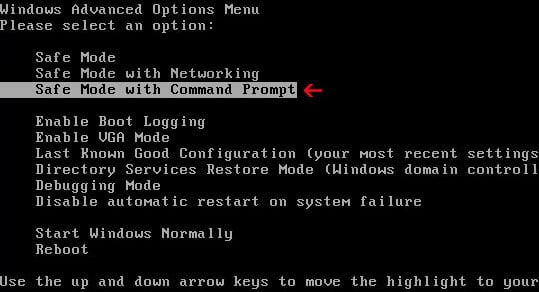


![Malwarebytes Anti-Malware final installation screen [Image: Malwarebytes Anti-Malware final installation screen]](http://malwaretips.com/blogs/wp-content/uploads/2013/01/malwarebytes-installation.jpg)
![Run a Quick Scan with Malwarebytes Anti-Malware [Image: Malwarebytes Anti-Malware Quick Scan]](http://malwaretips.com/blogs/wp-content/uploads/2013/01/malwarebytes-quick-scan.jpg)
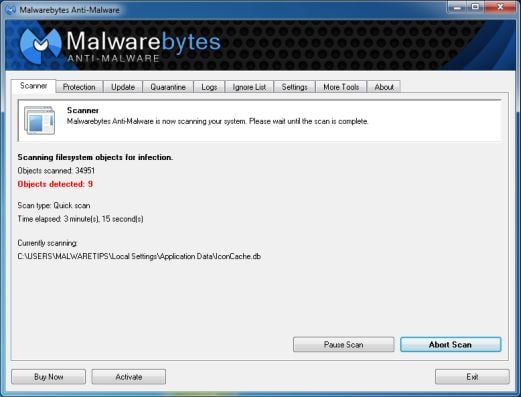
![Malwarebytes when the system scan has completed [Image: Malwarebytes Anti-Malware scan results]](http://malwaretips.com/blogs/wp-content/uploads/2013/01/malwarebytes-scan-results.jpg)
![Click on Remove Selected to get rid of Your computer has been locked virus [Image:Malwarebytes removing virus]](http://malwaretips.com/blogs/wp-content/uploads/2013/01/malwarebytes-virus-removal.jpg)
